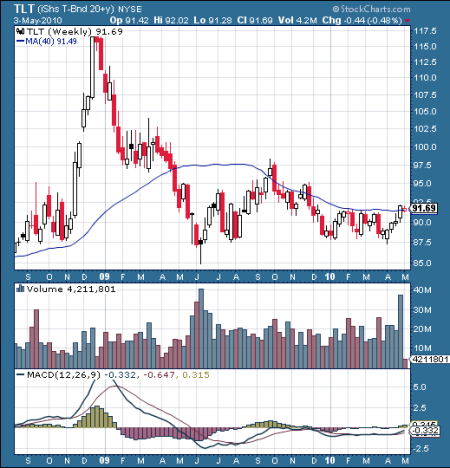SPX – 1073.65
DJIA – 10,066
“The market represents everything everybody knows, hopes, believes, anticipates, with all the knowledge sifted down to…the bloodless verdict of the market place.”
-William P. Hamilton
The fat lady belted out a tragic tale last week, a libretto about an angry bear, back from hibernation, cigar lit, pondering how to best go about its task, just the opposite of the bull whose post requires going up with as few investors onboard as possible. Music to the bear’s ear is the talking heads, cautious but unnerved, declaring it’s only a shake out to scare the weak hands, just what the bull wants. Pleased these “experts” can’t read the tape, the bear’s job is sink the market with as few investors in lifeboats as possible.
There’s not much to add to Friday’s alert. Price and time overbalanced for the S&P 500 (SPX) and its 3-day swing chart carved out a pattern of lower highs and lower lows, indicating the primary trend is down. The SPX also closed below its 5% weekly exponential moving average and a bear signal was recorded under Dow Theory when both the Dow Industrials and Transports closed below their respective May 7 lows on high volume.
I thought that Friday’s low might have ended the first section down but yesterday’s dead cat bounce said otherwise. Panic is in the air pre-opening and I think the SPX could slice under its February low (1044.50), confirming in yet another way that the primary trend is down. How far the stock market falls and how long the decline lasts are unknown, but I suspect the bottom of the first leg down is not far away in either price or time.
The Market Trend Indicator (MTI) is signaling DOWNTREND, each key index below its respective 18% weekly exponential moving average. The SPX’s 18% average is 1143.28 and the DJIA’s is and 10,639. The New York Advance/Decline line is 3,821 net declines below its 18% average. Net volume hurdle rates that need to be overcome to signal a reversal are (70.9) for the NYSE and (71.3) for NASDAQ.
From a technical perspective, it’s negative that virtually all the bull market leaders are under pressure, no change in the “buy low-sell high” mentality in place through the advance. Most recently, Travel & Tourism fell into the bottom ten group performance list as measured by relative strength. It was in the top ten list at year-end 2009. Foreign stock markets are highly correlated.
Other key markets continue to grapple with debt in Spain and political response to runaway debt, debt restructuring or currency debasement being the most likely options. Tension in Korea and a hint of China delusion add to concerns.
Flight-to-safety buying is driving government bond prices higher. I think a short position makes sense once the stock market puts in an intermediate-term bottom. Gold sold off last week but held well relative to other commodities. I’m curious as to how it reacts today. I want to see new all-time highs for gold on any recovery in the stock market or I start to worry about long positions as it appears markets are beginning to discount potential deflation.
Harmonic Preview:
(Higher Probability SPX Turning Point or Acceleration Days)
May 27 (Thursday)
June 2 (Wednesday)
Jun 11 (Friday)
June 14 (Monday)
June 25 (Friday)
*An asterisk denotes a dynamic SPX price square in time; different factors account for the other dates.
Conclusion:
I recommend lowering the stops for short positions to just above last Thursday’s intraday bounce high, 1029.24 for the SPX and down from just above its May 13 high at 1173.57. For the recovery rally, I would size positions (smaller) for a counter trend move. While small cap issues could still lead the advance, I plan to use ETFs tied to the SPX and NDX.
For investors, I think it’s a lot closer to the end that not for the first section down in the bear market. If you are the “buy low-sell high” sort and haven’t already implemented corrective action, I think it makes more sense to take defensive steps, not in a panic, but after first recovery rally, generally the largest in a bear market.
The information contained herein is based on sources that William Gibson deems to be reliable but is neither all-inclusive nor guaranteed for accuracy by Mr. Gibson and may be incomplete or condensed. The information and its opinions are subject to change without notice and are for general information only. Past performance is not a guide or guarantee of future performance. The information contained in this report may not be published, broadcast, rewritten or otherwise distributed without consent from William Gibson.







 Uncategorized |
Uncategorized | 
 Posted by mrmkt
Posted by mrmkt 




















